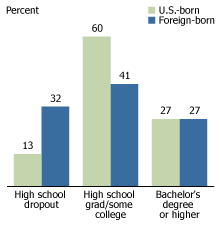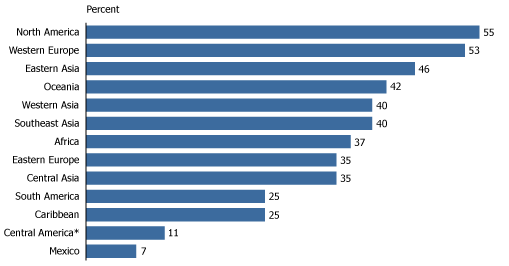Mark Mather
Associate Vice President, U.S. Programs

September 12, 2007
Associate Vice President, U.S. Programs
New estimates from the U.S. Census Bureau’s 2006 American Community Survey show that the number of foreign-born people in the United States has reached an all-time high of more than 37 million. Although policymakers, journalists, and the public have focused their attention on low-skilled migrants from Mexico and other Latin American countries, there is also a large and growing number of highly skilled immigrants arriving from Asia to attend college or work in America’s high-tech workforce. These two tiers of immigration have contributed to a wide economic divide among America’s foreign-born population.
In 2006, over one-half of the 37.5 million foreign-born residents in the United States were from Latin America, and over one-fourth were from Asia. Taken together, the population originating from Asia and Latin America make up four-fifths of all foreign-born residents. However, there are wide demographic and socioeconomic differences between these two groups. Those from Latin America tend to have less education, fewer skills, and lower incomes. They are filling jobs in construction, manufacturing, and the service sector, while those from Asia have higher incomes, on average, and are more likely to be enrolled in college or working in professional or managerial positions (see Table 1).
Table 1
Characteristics of Selected Subgroups of the U.S. Population,
by Country or Region of Birth, 2006
|
U.S.-born
|
Asian-born |
Latin Am.-born
|
|
|---|---|---|---|
| Population |
261,850,696
|
10,052,929
|
20,088,292
|
| Median household income |
$49,077
|
$61,823
|
$37,482
|
| Percent with at least a bachelor’s degree (ages 25 and older) |
27
|
48
|
11
|
| Percent without a high school diploma (ages 25 and older) |
13
|
16
|
47
|
| Percent with difficulty speaking English (ages 5 and older) |
2
|
47
|
65
|
| Percent in managerial and professional jobs (ages 16 and older) |
35
|
46
|
13
|
| Percent in construction, manufacturing, services (ages 16 and older) |
37
|
31
|
69
|
Source: Population Reference Bureau analysis of the 2006 American Community Survey.
Each year, the United States admits a large number of foreign students, mostly from Asia, to study at U.S. colleges. According to the Institute of International Education, there were 565,000 international students enrolled in U.S. colleges and universities in 2006, and most (58 percent) were from Asian countries.1 Other Asian students receive training in their home countries and are recruited, through employment-based visas, to work in America’s high-tech industries.2
In 2006, nearly half of the adult foreign-born population from Asia (48 percent) held at least a bachelor’s degree—more than four times the share of those from Latin America (11 percent). In contrast, the share of Latin American adults without a high school diploma (47 percent) was nearly three times the rate for foreign-born Asians (16 percent). Because of these differences, roughly equal proportions of foreign-born and U.S.-born residents have earned at least a bachelor’s degree. But the share of high school dropouts skews much higher for foreign-born residents (see Figure 1).
Figure 1
Educational Attainment of the U.S.-Born and Foreign-Born Populations, 2006

Source: Population Reference Bureau, analysis of the 2006 American Community Survey.
There are similar differences in the share of foreign-born workers in managerial or professional jobs. Among foreign-born workers, 46 percent of Asians were in professional jobs in 2006, compared with 13 percent of workers from Latin America. Among the foreign-born population from Asia, those from eastern Asia, which includes China, Japan, and Korea, were the most likely to be working as professionals. Among those from Latin America, those from Mexico and other Central American countries were the least likely to be in professional positions (see Figure 2). In 2006, 57 percent of foreign-born residents from Latin America were from Mexico.
Figure 2
Share of the Foreign-Born Population in Professional Occupations by Region of Birth, 2006

* Excludes Mexico.
Source: Population Reference Bureau analysis of the 2006 American Community Survey.
The relatively low level of education among foreign-born groups from Latin America is one of the key concerns cited by policymakers who are grappling with immigration issues. But there are wide state variations in the social and demographic characteristics of foreign-born residents. In some states, the foreign-born population has less education, on average, than the U.S.-born population, while the reverse is true in other states (see Table 2 (PDF: 45KB)).
Nationwide, there are roughly equal proportions of foreign-born and U.S.-born adults with at least a bachelor’s degree, at 27 percent each. However, there are several states (many in the Appalachian region) where the share of foreign-born residents with at least a bachelor’s degree is at least 5 percentage points higher than the U.S.-born population. There are also several states in the Southwest where the U.S.-born population is considerably more likely to hold a bachelor’s degree than their foreign-born counterparts.
The educational divide among foreign-born and U.S.-born residents is most acute at the high school level. Among the 50 states, there is only one—West Virginia—where the high school dropout rate for the foreign-born population is lower than that of U.S.-born residents.
The U.S. foreign-born population is heterogeneous, so policymakers need to be careful not to implement one-size-fits-all policies on immigration issues. While the primary concerns for some immigrants relate to legal status, poverty, low education, and English language ability, for others the hurdles relate to the availability of student visas and U.S. demand for highly skilled scientists and engineers.
